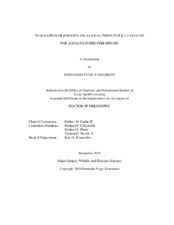| dc.description.abstract | Four separate studies were conducted with different finfish species, to explore the immunomodulatory properties of paramylon, a microalgae-derived linear form of β1,3-glucan, as an alternative to the widely available and branched yeast-based β-1,3-1,6- glucan products. In trials I and II, innate immune parameters were investigated in juvenile red drum (Sciaenops ocellatus) and Nile tilapia (Oreochromis niloticus) exposed ex vivo and in vivo to a crude microalgae-based commercial product, which provided 50% (wt/wt) of paramylon, compared to β-1,3-1,6-glucan products derived from yeast. Results verified the significant (P< 0.05) immunostimulatory properties of these compounds with isolated phagocytes from both species. Red drum and Nile tilapia fed the commercial paramylon product demonstrated a significantly (P< 0.05) increased total hemolytic activity and extracellular superoxide anion production, respectively, when fish were fed 100 mg kg^-1 compared to fish fed the basal diet. In trial III, the immunostimulatory efficacy was compared between purified paramylon and zymosan, the yeast-derived β1,3-1,6-glucan, when delivered as a feed additive or injected intraperitoneally to hybrid striped bass(Morone chrysops × M. saxatilis). Juvenile fish fed both beta-glucans at 50 and 100 mg kg^-1 diet had significantly (P< 0.05) increased respiratory burst by isolated phagocytes compared to fish fed the basal diet. Fish fed diets with paramylon at 50 mg kg^-1 had increased plasma levels of immunoglobulin. The intraperitoneal injection trial exposed sub-adult hybrid striped bass to β-glucan solutions (10 mg β-glucan kg-^1 body weight). All immunological profiles from whole blood and plasma were modulated differently depending on the source of β-glucan. In trial IV the synergistic potential between vitamin C and paramylon was evaluated regarding immunological responses of hybrid striped bass ex vivo and in vivo. The ex vivo model was more responsive than in vivo, and showed most of the immunological parameters were significantly (P< 0.05) enhanced either by vitamin C, the β-glucan or their combination. The feeding trial demonstrated increased production of reactive oxygen species and health-related intestinal enzyme activities of juvenile hybrid striped bass fed these two supplements. The compiled results from these studies support the supplementation of paramylon as a novel β-glucan additive to enhance immunological responses of farmed fish. | en |


